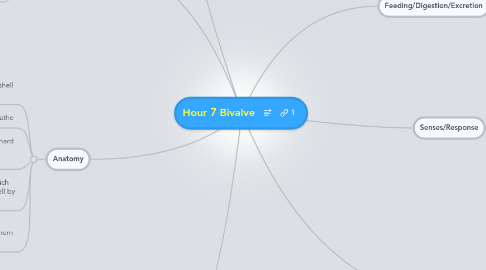Hour 7 Bivalve
by Karla Lockman

1. Respiration
1.1. They breathe through gills.
1.2. They get oxygen from breathing.
1.3. They can survive several hours without water by tightly closing their their shells
2. Anatomy
2.1. All Bivalves have abductor muscles that help keep the shell closed.
2.2. Bivalves have gills that help them breathe
2.3. Bivalve name refers to the two hard outer shells surrounding the animal.
2.4. Bivalves have umbros which make the point of the shell by the hinge.
2.5. Bivalves have a mantle,which works as a respiratory chamber, and usually helps them feed
3. Reproduction/Life Cycle
3.1. Bivalves can activly move to find a mate and reproduce.
3.2. The sexes are usually separate in bivalves but some hermaphroditism is known
3.3. Spawning may take place continually or be triggered by environmental factors such as day length, water temperature or the presence of sperm in the water.
4. Circulation
4.1. blood is pumped out of the heart and goes through a few large vessels to the tissues where it exists the arteries and enters large open spaces where it passes over the cells of various organs. This is what delivers oxygen from the gills to the organs.
5. Feeding/Digestion/Excretion
5.1. They feed on plankton
5.2. they filter feed
5.3. with a pair of tentacles at the edge of the mouth, each of which has a single palp, or flap. The tentacles are covered in mucus, which traps the food
6. Senses/Response
6.1. Have light sensitive eyes that allow them to detect. ie. respond by closing valves when predators are nearby.
6.2. sense changes in water flowing
6.3. hair-like projections (cilia) sense the environment around them
7. Movement
7.1. Free moving, use a muscle called a foot to thrust forward.
7.2. Boring, can bore into soft rocks and wood.
7.3. Sessile, attach to hard surface and stay there for life.
7.4. Burrowing, burrow into sand and become stuck in it for life.
7.5. Slime, create slime on foot to help burrow into ground.


